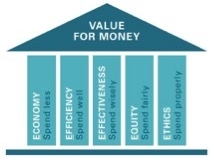
Value for money is at the very heart of public finance management. The concept of value for money can be broadly defined as “something that is well worth the money spent on it”. In its most recent publication, CABRI presents important insights and an innovative framework to assist countries in making value for money decisions.
The “5 Es” of budgeting – efficiency, effectiveness, economy, ethics and equity – which serve to determine if value for money is achieved – is a recurring theme in the publication. Essentially, governments achieve value for money when they have the right policies (given specific needs), choose the most cost-effective interventions, and implement these interventions efficiently, fairly and with moral considerations.
Value for money requires all participants in the budget process to think differently about each decision within this complex cycle, and to understand the true extent of policy choices and trade-offs within the process. Within this flow of decisions, the accountability of each practitioner for the decisions and choices made, is vital. The budget process presents opportunities for debate about achieving value for money at every stage and decision point, whether in planning, financing, managing, implementing or reporting.
Key performance indicators (KPIs) are an important tool to drive value for money. KPIs have advantages, such as driving demand for performance information, they can strengthen performance auditing, support performance incentives linked to bonuses, and inform the general public – but they can have unintended consequences, too. For example, there may be cases, where the ‘gaming’ of indicators takes place (such as KPIs targeting lower levels of quality/quantity than expected, in order to demonstrate higher performance). If targets are low, officials may demonstrate limited efforts to exceed them and therefore, the need for good KPIs is vital.

For this and other reasons, making value for money decisions is quite complex. The complexity of these policy decisions is well illustrated in a chapter that presents three real country case studies. One of these case studies relates to the case of malaria in Zanzibar. Although Zanzibar has reduced malaria prevalence to 1% of its population, it could choose to maintain this position or attempt to eradicate the disease entirely. While the latter has long term socio-economic benefits, it also presents tremendous costs. The publication presents the highlights of this discussion (and of the other case studies) and the conclusions reached.
To some extent, analytical tools can assist in making these difficult policy decisions. Tools such as cost-benefit analysis, cost-effectiveness analysis and impact evaluation are discussed in the report. These tools can be applied to a range of sectors and can be very powerful in assessing the appropriateness and effectiveness of spending programmes.
Exploring and finding ways in which public spending can be efficient, effective, economic, ethical and equitable will remain a crucial pillar of CABRI’s work over the medium term. In this regard, we will continue to work with officials from finance and line ministries through our policy dialogues, in-country workshops, training programmes and other knowledge-exchange activities.
We hope that the use of the various tools and principles that are contained in the 10th annual seminar publication will help to make value for money less elusive than the “holy grail”. To read the CABRI 10th